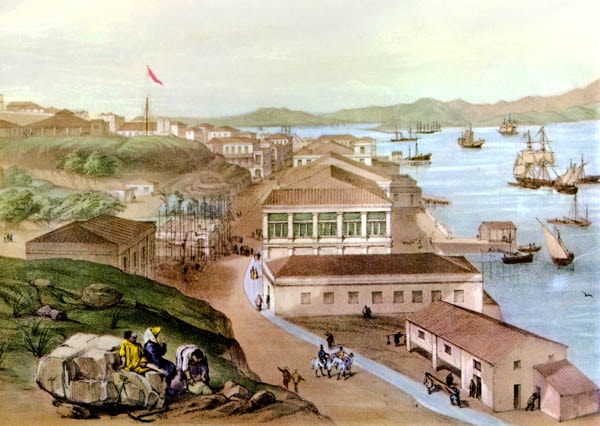From 1841 to the turn of the century, no fewer than 50 ordinances relating to shipping were passed and enacted. These included ordinances on the control of the harbour, prevention of piracy, registration of colonial vessels and regulations with respect to Chinese passenger ships. The following ordinances were passed during the period 1841-1859:[14]
- 1841 Rules and regulations for British merchant shipping and for the Marine Magistrate were published; Hong Kong was declared a free port
- 1844 An ordinance for the better regulation of the harbour and surrounding waters of the Island of Hong Kong
- 1845 An ordinance for the further regulation of the harbour of Hong Kong
- 1847 An ordinance for the prevention of piracy
- 1852 An ordinance for the prevention of desertion, and better regulation of merchant seamen in the Colony
- 1854 The Merchant Shipping Act
- 1855 An ordinance to establish a proper system of registration for colonial vessels
- 1855 An act for the regulation of Chinese passenger ships
- 1856 An ordinance to explain certain enactments relating to shipping
- 1858 An ordinance for the continuance of the theretofore existing regulations with respect to Chinese passenger ships; and in the case of British ships, with respect to the treatment of their passengers therein whilst at sea
Hong Kong Island was seized primarily because it provided a safe and convenient location for entrepot trade. Effective control of the harbour and regulation of shipping were thus of great importance. Whilst the Harbour Master was in place to oversee the harbour and shipping, ordinances regarding control of these areas were passed and enacted to provide the necessary legal framework. They were amended, repealed, and replaced by other ordinances from time to time when deemed necessary. Ordinances passed in the early period covered three main categories, i.e. control of the harbour, registration of vessels, and matters relating to Chinese passenger ships.
As early as 1841, with reference to British rule, there were already preliminary regulations applied to Hong Kong harbour. As proclaimed by Charles Elliot, H. M. Plenipotentiary, the rules and regulations for British merchant shipping were to be applicable to British ships anchored in, and thereafter arriving in, Hong Kong waters, with a magistrate to be appointed to handle possible violations of the rules.[15]
The first ordinance to regulate the harbour was introduced as No. 19 of 1844. It was received with suspicion by the local boatmen. Unhappy with the legislation, many boatmen left for Huangpu, and trade was disrupted. In view of this, the second Governor, Sir John Davis, repealed and replaced it with Ordinance No. 11 of 1845.[16]
Desertions of seamen were common at the time, and they in turn affected trade. Following a petition from the maritime community, an ordinance for better regulation of seamen was introduced in 1852. Boarding houses were set up to accommodate seamen on land.
In 1855, an ordinance to establish a proper system for the registration of colonial vessels was passed.[17] It was the first piece of legislation defining colonial vessels and introducing a system of registration.
From the late 1840s onwards, there was a drastic increase in Chinese free emigrants and contract coolie labourers leaving for North America and other parts of the world through Hong Kong. The figures escalated in the 1850s, whilst the conditions on board ships were found to be often inhumane and consequently attracted substantial criticism. Through a series of Passengers’ Acts, the colonial government attempted to improve the situation by laying down minimum standards for ship accommodation to which shipowners were obliged to adhere. The Chinese Passengers Act 1855 for the regulation of Chinese passenger ships was the first legislation addressing this matter. Schedule A to the legislation set out regulations which all Chinese passenger ships had to abide by, including among other things that the ships were required to be seaworthy and properly manned, equipped, fitted and ventilated; that space appropriated to each adult should be no less than 72 cubic feet; that sufficient provisions, fuel, and water needed to be placed on board for the duration of the intended voyage; and that the vessels had to be provided with lifeboats and life-saving appliances. Even the dietary scale for passengers was stipulated. The act was supplemented by related ordinances in 1856 and 1858, and by yet further ordinances in subsequent years.
Notes:
- [14]
‘Chronological Table of Ordinances’, The Laws of Hong Kong, Revised Edition (Hong Kong: The Government Printer, 1966).
- [15]
CO 129/10, Rules and Regulations for the British Merchant Shipping, pp. 9-10.
- [16]
James William Norton-Kyshe, The History of the Laws and Courts of Hong Kong from the earliest period to 1898 (Hong Kong: Vetch and Lee, 1971), p. 89; 馬沅:《香港法制史實彙編》(第一卷乙冊)〈港務局及海事庭之設立〉(香港:華僑日報,1936),頁102-103。
- [17]
An Act for the Regulation of Chinese Passenger Ships, 18 and 19 Victoria, 14 August 1855.
Part 1 Chapter 2.3 - Ordinances relating to the regulation of vessels and control of the harbour and the surrounding waters from 1841 to 1859



